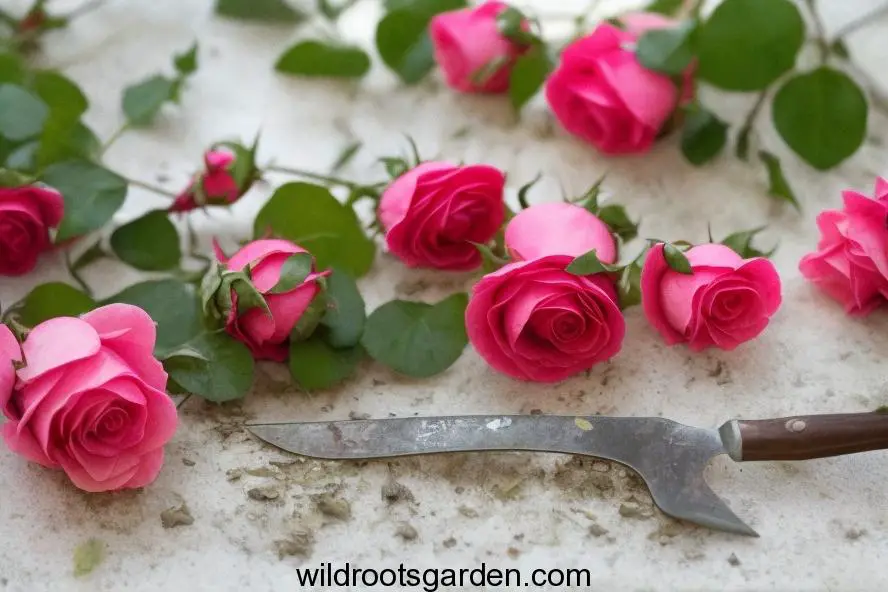Why Are My Rose Cuttings Dying? This investigation, which delves into the field of horticulture, tries to solve the mystery of the failure of rose cuttings to flourish. When their delicate cuttings don’t thrive as expected, aspiring gardeners and enthusiasts frequently experience frustration. This study explores the complex interactions among the many variables that contribute to this occurrence, including soil moisture content, temperature swings, and propagation methods.
We aim to debunk these devastating setbacks’ underlying causes using an analytical viewpoint. Are problems a result of poor cutting angles, insufficient rooting hormone delivery, or poor transplanting techniques? We aim to equip green fingers with the knowledge to prevent the untimely demise of their rose cuttings by breaking down these potential problems and incorporating professional opinions.
Join us as we go on a quest to restore the health of your precious rose cuttings and create a greater understanding of effective replication methods as we peel back the layers of this botanical enigma.
The Art of Propagating Roses

The delicate technique of propagation entails growing new plants from old ones. Rose cuttings can be used to replicate the desired traits of a certain rose variety. Although it may appear to be a simple process, a number of conditions must be met for it to be effective.
Choosing the Right Cutting
The first step to success is choosing a healthy, disease-free cutting. Choose a stem that doesn’t have any imperfections, illnesses, or stress signals. A cutting will have a better chance of flourishing if it has at least two sets of leaves and a latent bud.
The Role of Timing
In order for rose propagation to be successful, timing is essential. The dormant season of the plant, which is normally in late winter or early spring, is the ideal time to take cuttings. The plant is concentrating its energy on developing its roots at this time.
Nurturing the Growing Medium
The cutting’s ability to produce roots is supported by the growth media. The best conditions for root development are provided by peat moss, perlite, and vermiculite mixture that drains efficiently.
Watering Wisely
Proper watering is essential to prevent the cutting from drying out or becoming waterlogged. Maintain a balance between moisture and drainage to encourage healthy root development.
The Vital Importance of Humidity
High humidity levels in the area around the cutting might greatly increase the likelihood of success. The appropriate humidity can be maintained by using a misting system or covering the cutting with a plastic dome.
Let There Be Light
Adequate light is crucial for photosynthesis and overall growth. Place the cuttings in a bright, indirect light location to ensure they receive the energy they need.
Temperature Tango
Temperature fluctuations can stress the cuttings. Maintain a consistent temperature range to provide a stable environment for root growth.
Warding Off Pests and Diseases
Inspect the cuttings regularly for any signs of pests or diseases. Swift action will prevent potential infestations from jeopardizing the cutting’s chances of survival.
The Dilemma of Overfertilization
While nutrients are essential, overfertilization can harm the delicate cuttings. Use a balanced, diluted fertilizer sparingly to provide the necessary nourishment.
Patience: A Virtue in Rose Propagation
Rome wasn’t built in a day, and neither are strong, healthy roots. Patience is key as the cuttings gradually develop the root system needed for successful transplantation.
When and How to Transplant
Transplant the cuttings into larger pots once they have developed a robust root system. Handle the fragile roots with care to minimize stress during transplantation.
Celebrating Successes: Rooting Hormones
Rooting hormones can give your cuttings an extra boost by encouraging root development. Dip the base of the cutting in a rooting hormone before planting.
***We have traveled over the complex terrain of horticultural science in our attempt to discover the mysteries underlying the life of rose cuttings. You are now prepared to navigate the difficulties and tenderly care for your cuttings thanks to your newly acquired insights. Keep in mind that success frequently results from a combination of knowledge, perseverance, and a sincere love for the craft of gardening.
May your efforts result in flourishing rose bushes that serve as a monument to your commitment as you set out on your adventure to propagate and cultivate these prized blooms. Let this investigation serve as a reminder that, despite setbacks, the horticulture industry is a place for ongoing learning and development.
May your future endeavors be adorned with the vibrant beauty of flourishing rose cuttings, and may your garden flourish with the delicate elegance that these blooms bring. Happy gardening!
FAQs
How long does it take for rose cuttings to root?
The rooting process usually takes around 4 to 8 weeks, depending on factors like temperature and humidity.
Can I use any type of soil for propagating rose cuttings?
It’s best to use a well-draining mix of peat moss, perlite, and vermiculite for optimal root development.
Is misting rose cuttings necessary?
Misting can help maintain high humidity levels, which are beneficial for root growth, especially in the initial stages.
What is the best time of day to water rose cuttings?
Morning is the ideal time to water rose cuttings, allowing them to absorb moisture before the day’s heat sets in.
Can I propagate roses in water?
While it’s possible to propagate roses in water, it’s generally more successful to use a well-draining growing medium for healthier root development.

